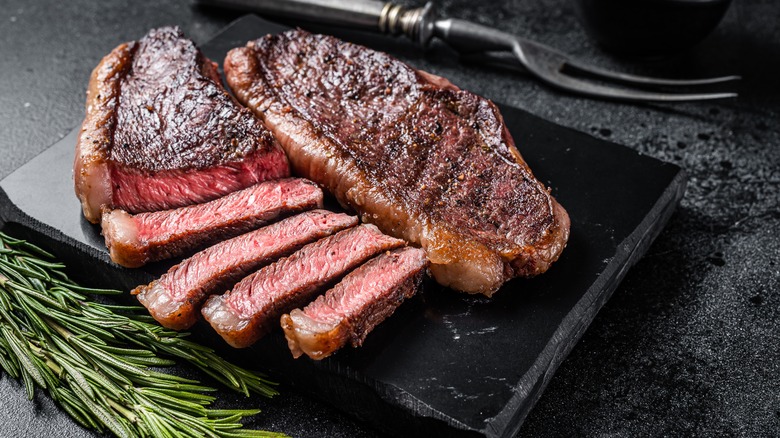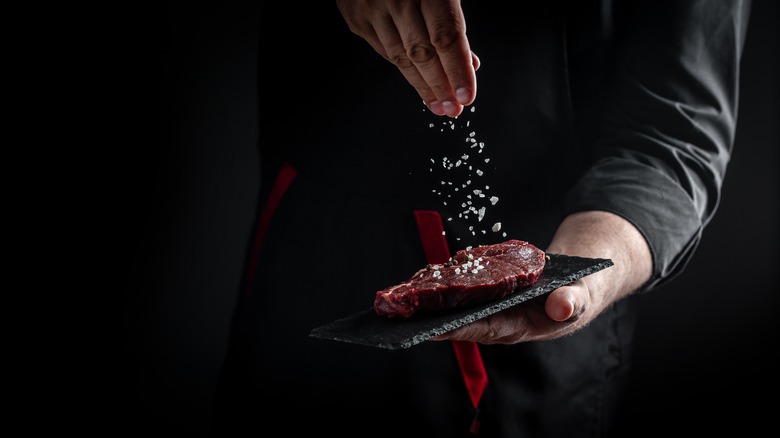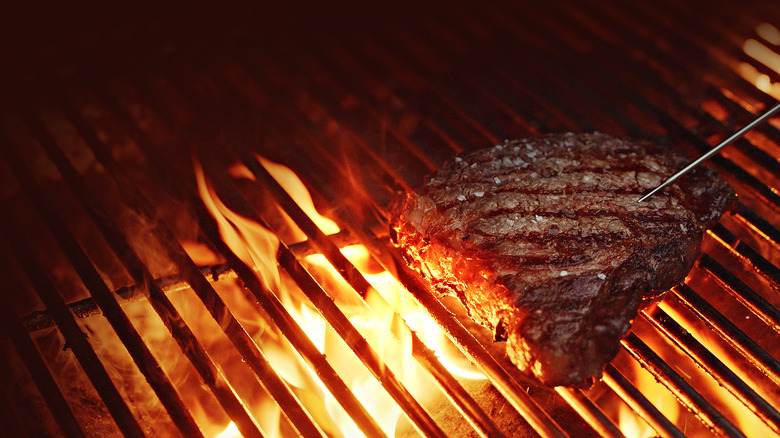The Salting Mistake That Prevents A Satisfying Crust On Steak
There is perhaps no food more glorified than a perfectly cooked steak. It is simultaneously one of the simplest dishes to make, requiring little equipment — just a grill or a cast iron pan — and while you're welcome to butter-baste it with garlic and herbs, all steak needs is a healthy sprinkling of salt to bring out its rich and complex flavor. And yet, despite its superficial simplicity, the art of cooking steaks has become one of the most highly scrutinized skills in the world of cooking.
Much of the coverage concerning steak focuses on the level of doneness. The quest for the perfect medium-rare steak has inspired countless articles, videos, and even scientific studies. But, the interior of a steak only tells half the story. It could be argued that the exterior is more important, being the chief source of the rich, umami flavor that makes steak so craveable.
The crust on a steak is the result of a chemical process called the Maillard reaction. Around 300 degrees Fahrenheit, the amino acids that make up the proteins in the meat break down, forming somewhere around 3,000 to 4,000 unique chemical compounds, producing a vast array of aromas and opening new dimensions of flavor. However, this reaction can only occur in a dry environment because liquids cannot reach the required temperature. If there's moisture on the surface of your steak, the perfect crust will elude you, and the chief culprit might be salt.
Salting steak is all about timing
The advantages of salting your meat go far beyond taste. Salt helps to trap water molecules inside the muscle of the meat, preventing it from becoming dry and tough. However, this process takes about 40 minutes. During the first few minutes after salting your steak, the salt slowly draws moisture out of the muscle and up to the surface of the meat. There, the salt and water mingle, forming a brine. As the salt gradually breaks down the proteins in the steak, that brine begins to seep back into the meat, creating a moisture-packed environment that ensures a tender and juicy end product.
Now, here's the trick. After the salt draws out the moisture in the meat, it takes about 10-20 minutes for the brine to start reabsorbing into the muscle. During that time, the surface of the steak will be quite wet, and that will prevent you from getting a satisfying crust. There are two ways to avoid this pitfall. You can either salt your steak immediately before cooking it, or you can wait at least 40 minutes after salting your steak to start cooking it. The latter method is preferable because it will ensure a nice, juicy bite. Many chefs recommend salting your steaks as soon as you get home from the grocery and letting them sit like that in the fridge for a day or two before cooking. Keeping the meat uncovered will ensure a dry surface.
More tips for the perfect steak crust
Timing when you salt your steak is crucial to forming a good crust, but there are additional tricks you can use to get that perfect char. On the subject of salting, it's essential to be heavy-handed. A light sprinkling of salt won't do much for your meat, so if you're a beginner, you should probably use more salt than you think. You'd assume this would make the steak just taste like salt, but remember that salt helps bring out the full flavor of the meat, so it helps with complexity. It takes some practice to learn the perfect salt level for your tastes, but there are lots of affordable steak cuts for beginners to help you master your technique without burning a hole in your wallet.
Aside from surface moisture, the two most important factors in achieving a good crust on your steak are cooking temperature and time. You must cook your steaks in a ripping hot pan or grill. It should be sizzling like hot bacon as soon as it hits the heat. This is critical because you want the exterior of the steak to cook very fast, getting brown and crispy before the interior overcooks to gray leather.


